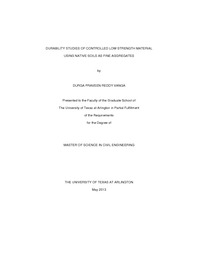
ATTENTION: The works hosted here are being migrated to a new repository that will consolidate resources, improve discoverability, and better show UTA's research impact on the global community. We will update authors as the migration progresses. Please see MavMatrix for more information.
Show simple item record
| dc.contributor.author | Vanga, Durga Praveen Reddy | en_US |
| dc.date.accessioned | 2013-07-22T20:13:21Z | |
| dc.date.available | 2013-07-22T20:13:21Z | |
| dc.date.issued | 2013-07-22 | |
| dc.date.submitted | January 2013 | en_US |
| dc.identifier.other | DISS-12150 | en_US |
| dc.identifier.uri | http://hdl.handle.net/10106/11797 | |
| dc.description.abstract | Controlled Low Strength Material using native soils as fine aggregates is an effective option in addressing issues relating to strength requirements, sustainability, and project cost. Using native soil in the place of conventional aggregate will greatly reduce the overall project costs and will enhance the sustainability of the project as it eliminates dumping of excavated material in a landfill. CLSM mixes, designed for the particular flowing characteristics as well as the compressive strength should maintain targeted engineering properties throughout its design life period to minimize long term maintenance cost. Though CLSMs do meet the short term strength requirements, their long-term performance should be verified in order to be successfully used in the actual site, especially when these materials are subjected to seasonal variations such as wetting and drying.This research attempts to assess the long-term performance of CLSM through durability studies. CLSMs using native soils from Woodbine, Eagle Ford, Austin Chalk and Queen City Sand geological formations were analyzed in terms of unconfined compressive strength, volumetric strain changes, weight changes and calcium concentration loss through wetting/drying and leachate collection. The effects of soil type and calcium concentration loss on the long-term performance of CLSMs are addressed .Comparative studies between field and laboratory prepared specimens are conducted to study the effects of preparation methods on the performance of CLSMs.A total of six different CLSM mxes including four CLSMs prepared in the field and two preperared in the laboratory with mix designs developed by Fugro Consultants Inc were study in this research. Each of these samples were subject to durability studies comprising of both wetting/drying durability and leaching of stabilizer during rainfall infiltration. Test results and analysis indicated that CLSM with high plasticity clay was less durable when compared with CLSMs of other soil types. Further recommendations were made for field monitoring methods to validate the laboratory test results. | en_US |
| dc.description.sponsorship | Puppala, Anand | en_US |
| dc.language.iso | en | en_US |
| dc.publisher | Civil & Environmental Engineering | en_US |
| dc.title | Durability Studies Of Controlled Low Strength Material Using Native Soils As Fine Aggregates | en_US |
| dc.type | M.S. | en_US |
| dc.contributor.committeeChair | Puppala, Anand | en_US |
| dc.degree.department | Civil & Environmental Engineering | en_US |
| dc.degree.discipline | Civil & Environmental Engineering | en_US |
| dc.degree.grantor | University of Texas at Arlington | en_US |
| dc.degree.level | masters | en_US |
| dc.degree.name | M.S. | en_US |
Files in this item
- Name:
- Vanga_uta_2502M_12150.pdf
- Size:
- 4.867Mb
- Format:
- PDF
This item appears in the following Collection(s)
Show simple item record


